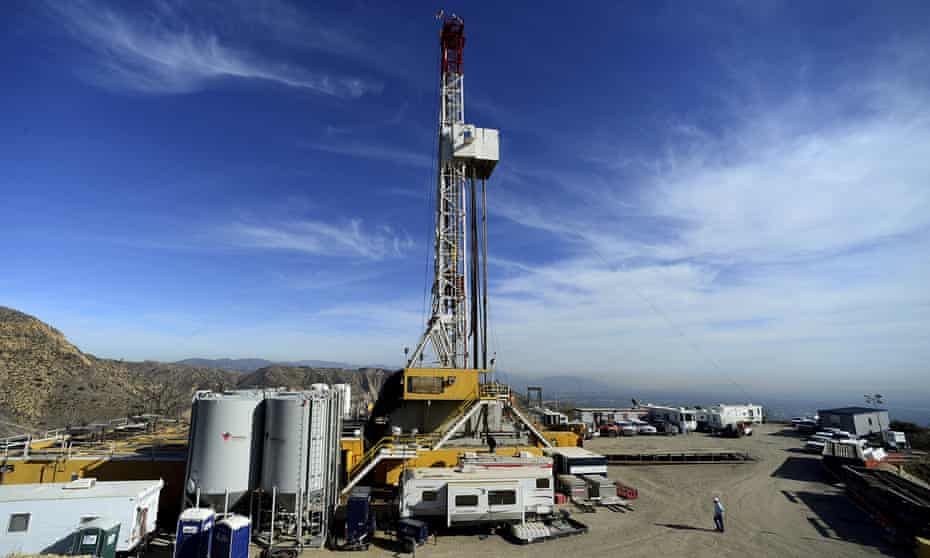Critics say the decision comes at a high cost to both the climate and human health

In this 9 December 2015 photo, crews work on a relief well at the Aliso Canyon facility above the Porter Ranch area of Los Angeles.
Photograph: Dean Musgrove/AP
Gabrielle Canon and agencies
THE GUARDIAN
Fri 5 Nov 2021
Gabrielle Canon and agencies
THE GUARDIAN
Fri 5 Nov 2021
California regulators voted Thursday to increase the capacity of a Los Angeles natural gas storage field, where a 2015 blowout caused the nation’s largest-ever methane leak and forced thousands from their homes.
Locals, environmental advocates, and lawmakers have called for the closure of the facility, which has been approved to increase more than 20% in capacity.

‘They’re killing our children’: mothers from around the world demand action on fossil fuels
The California Public Utilities Commission (CPUC) voted unanimously to increased the storage capacity of the underground Aliso Canyon field to 41bn cubic feet (1.1bn cubic meters) of natural gas from 34bn cubic feet (962m cubic meters), citing concerns that winter energy needs could otherwise go unmet.
“Our decision today helps ensure energy reliability for the Los Angeles Basin this winter in a safe and reliable manner,” Commissioner Martha Guzman Aceves said in a statement, adding that the agency will continue considering how to close the facility as California transitions to “a clean energy economy”.
Officials also framed the plan as a compromise. An alternative plan proposed an increase to more than 68bn cubic feet – Aliso Canyon’s maximum capacity.
California has some of the most ambitious environmental goals and policies in the nation, and has pledged to produce all its energy from clean sources by 2045. But the state has also struggled to keep the lights on with rolling blackouts and energy shortages, which have been complicated by the drought’s strain on hydroelectric power.
Over the summer, as temperatures surged and air conditioners blasted, the California governor declared a state of emergency over the energy supply strain, estimating a 3,500 megawatt shortage. The state projects next summer will be worse, and officials say the deficit could grow to 5,000 megawatts in 2022 – the amount needed to power roughly 5.2m homes.
But critics of the increase are concerned that relying on natural gas as a stopgap comes at a high cost to both the climate and human health.

Southern California residents affected by the blowout of the SoCalGas Aliso Canyon storage protest outside Governor Gavin Newsom’s home last year.
Photograph: Paul Kitagaki Jr/ZUMA Wire/REX/Shutterstock
Neighbors and activists who want Aliso Canyon permanently closed said the increase was unnecessary and had urged the CPUC to reject it. Senators Dianne Feinstein and Alex Padilla have joined in calling for its closure.
“More than six years after the well failure at Aliso Canyon endangered the health of more than 7,000 families, it is increasingly clear that we must close this facility in order to protect the safety of Californians,” they wrote in a joint statement issued before the decision.
A well failure on 23 October 2015 led to the release of nearly 100,000 tons of methane and other substances into the air for nearly four months before it was controlled.
The blowout was blamed for sickening thousands of residents who moved out of their homes near the San Fernando Valley to escape a sulfurous stench and maladies such as headaches, nausea and nose bleeds.
Before Thursday’s vote, some families told the commission they still smell gas and one Porter Ranch resident said she was afraid to open her windows, the Los Angeles Daily News reported.
“The Public Utilities Commission voted today in favor of fossil fuel interests, not the wellbeing of California ratepayers,” said Food & Water Watch’s California director Alexandra Nagy in a statement. “Allowing any increase in storage capacity at SoCalGas’ Aliso Canyon facility is not only dangerous, it is needless,” she added, saying that it will create a “disastrous glut” of natural gas.
SoCalGas said Aliso Canyon and other storage facilities will be essential in delivering gas and keeping energy prices stable this winter, when prices are expected to rise nationwide and interstate pipeline repairs limit regional supplies.
SoCalGas spent more than $1bn on the the blowout, with most of the sum going toward temporarily relocating 8,000 families.
State regulators found SoCalGas failed to investigate previous well failures at the storage site and didn’t adequately assess its aging wells for disaster potential before the blowout.
Last month, SoCalGas and its parent company, Sempra Energy, agreed to pay up to $1.8bn to settle lawsuits by 35,000 people. The agreement is subject to about 97% of plaintiffs accepting it and could be reduced if fewer agree.
SoCalGas previously reached a $120m court settlement with the state attorney general and agreed to a $4m settlement with Los Angeles county prosecutors after being convicted in Los Angeles superior court of failing to quickly report the leak to state authorities.
Neighbors and activists who want Aliso Canyon permanently closed said the increase was unnecessary and had urged the CPUC to reject it. Senators Dianne Feinstein and Alex Padilla have joined in calling for its closure.
“More than six years after the well failure at Aliso Canyon endangered the health of more than 7,000 families, it is increasingly clear that we must close this facility in order to protect the safety of Californians,” they wrote in a joint statement issued before the decision.
A well failure on 23 October 2015 led to the release of nearly 100,000 tons of methane and other substances into the air for nearly four months before it was controlled.
The blowout was blamed for sickening thousands of residents who moved out of their homes near the San Fernando Valley to escape a sulfurous stench and maladies such as headaches, nausea and nose bleeds.
Before Thursday’s vote, some families told the commission they still smell gas and one Porter Ranch resident said she was afraid to open her windows, the Los Angeles Daily News reported.
“The Public Utilities Commission voted today in favor of fossil fuel interests, not the wellbeing of California ratepayers,” said Food & Water Watch’s California director Alexandra Nagy in a statement. “Allowing any increase in storage capacity at SoCalGas’ Aliso Canyon facility is not only dangerous, it is needless,” she added, saying that it will create a “disastrous glut” of natural gas.
SoCalGas said Aliso Canyon and other storage facilities will be essential in delivering gas and keeping energy prices stable this winter, when prices are expected to rise nationwide and interstate pipeline repairs limit regional supplies.
SoCalGas spent more than $1bn on the the blowout, with most of the sum going toward temporarily relocating 8,000 families.
State regulators found SoCalGas failed to investigate previous well failures at the storage site and didn’t adequately assess its aging wells for disaster potential before the blowout.
Last month, SoCalGas and its parent company, Sempra Energy, agreed to pay up to $1.8bn to settle lawsuits by 35,000 people. The agreement is subject to about 97% of plaintiffs accepting it and could be reduced if fewer agree.
SoCalGas previously reached a $120m court settlement with the state attorney general and agreed to a $4m settlement with Los Angeles county prosecutors after being convicted in Los Angeles superior court of failing to quickly report the leak to state authorities.
No comments:
Post a Comment